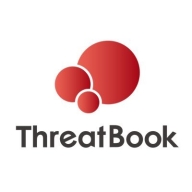

VirusTotal and ThreatBook compete in the cybersecurity tools category. VirusTotal often seems to have the upper hand in price and support, while ThreatBook is favored for its advanced feature set.
Features: VirusTotal offers rapid analysis of files and URLs with a multi-faceted scanner, swift threat detection, and community-driven intelligence. ThreatBook provides advanced threat intelligence for enterprises with in-depth analyses and context-rich details. VirusTotal focuses on broad threat detection, whereas ThreatBook delivers detailed insights for targeted security operations.
Ease of Deployment and Customer Service: VirusTotal has a straightforward deployment process with robust integration options. Its customer support relies mainly on online resources. ThreatBook provides a tailored deployment experience and dedicated customer service, suitable for those needing more personalized setup assistance.
Pricing and ROI: VirusTotal is praised for cost-effectiveness, offering a valuable free tier and excellent community contributions. ThreatBook, despite a higher price point, provides considerable ROI due to its advanced features and integration. For advanced threat intelligence, ThreatBook's investment is justified by comprehensive protection.

ThreatBook is a cybersecurity platform that provides advanced threat intelligence to protect networks from evolving threats, utilizing real-time data analytics and comprehensive reporting to bolster defenses.
Designed for enterprises, ThreatBook equips IT teams with insights into the latest threats, integrating seamlessly with existing security infrastructures. It focuses on proactive threat detection and incident response, offering a deep understanding of threat landscapes. The platform is appreciated for its ability to deliver actionable intelligence, enhancing overall network security posture.
What are the key features of ThreatBook?In finance, ThreatBook implementation helps safeguard sensitive financial data, while in healthcare it protects patient information by preventing data breaches. It also supports manufacturing businesses by securing intellectual property from cyber espionage. Each industry benefits from features tailored to its specific threat landscape and priorities.
VirusTotal is an essential tool for gathering malware information, analyzing compromised data, and monitoring malicious campaigns.
VirusTotal enables users to examine malware hashes, create alerts for targeted attacks, and utilize IOCs and YARA rules to detect threats. Its private scanning capabilities ensure discreet file analysis, while the API assesses IP address threats. Widely used in sectors like retail and FinTech, VirusTotal significantly boosts productivity.
What are the most valuable features of VirusTotal?VirusTotal is highly valued in industries like retail and FinTech, where it assists in examining malware hashes, creating alerts, and utilizing IOCs and YARA rules for advanced threat detection. Despite its valuable features, there is room for improvement in its interface, automation, AI integration, and API connectability, areas where competitors sometimes offer more advanced solutions.
We monitor all Threat Intelligence Platforms reviews to prevent fraudulent reviews and keep review quality high. We do not post reviews by company employees or direct competitors. We validate each review for authenticity via cross-reference with LinkedIn, and personal follow-up with the reviewer when necessary.